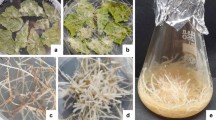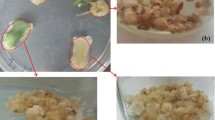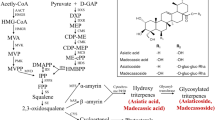Abstract
In the present study, metabolic engineering approach was used through over-expressing the Petunia chalcone synthase (chsA) gene in order to enhance the silymarin production level in the hairy root cultures of Silybum marianum. Molecular analysis confirmed the presence and integration of chsA transgene in transgenic hairy roots. Chemical analysis indicated that the over-expression of chsA gene enhanced the silymarin production level in the transgenic line as much as 7-folds than the non-transgenic hairy roots. Moreover, the silybin content, the main active component of silymarin, was proved to be 10 times higher in transgenic hairy roots than those of the non-transgenic ones. Therefore, the over-expression of petunia chsA gene in S. marianum hairy roots did not result in gene silencing, but led to an enhanced biosynthesis of the flavonolignans.






Similar content being viewed by others
Abbreviations
- chsA:
-
Chalcone synthase
- SB:
-
Silybin
- ISB:
-
Isosilybin
- SD:
-
Silydianin
- SC:
-
Silychristin
- TXF:
-
Taxifolin
- CoA:
-
Coenzyme A
References
Crocenzi FA, Roma MG (2006) Silymarin as a new hepatoprotective agent in experimental cholestasis: new possibilities for an ancient medication. Curr Med Chem 13:1055–1074
Doyle JJ, Doyle JL (1990) Isolation of plant DNA from fresh tissue. Focus 12:13–15
Fukusaki E, Kawasaki K, Kajiyama S, An CI, Suzuki K, Tanaka Y, Kobayashi A (2004) Flower color modulations of Torenia hybrida by downregulation of chalcone synthase genes with RNA interference. J Biotechnol 111:229–240
Gomez-Galera S, Pelacho AM, Gene A, Capell T, Christou P (2007) The genetic manipulation of medicinal and aromatic plants. Plant Cell Rep 26:1689–1715
Hasanloo T, Khavari-Nejad RA, Majidi E, Shams-Ardakani MR (2005) Analysis of flavonolignans in dried fruits of Silybum marianum (L.) Gaertn from Iran. Pak J Biol Sci 8:1778–1782
Hasanloo T, Sepehrifar R, Rahnama H, Shams MR (2009) Evaluation of the yeast-extract signaling pathway leading to silymarin biosynthesis in milk thistle hairy root culture. World J Microbiol Biotechnol 25:1901–1909
Khalili M, Hasanloo T, Kazemi Tabar SK, Rahnama H (2009) Influence of exogenous salicylic acid on flavonolignans and lipoxygenase activity in the hairy root cultures of Silybum marianum. Cell Biology International 33:988–994
Khalili M, Hasanloo T, Kazemi Tabar SK (2010) Ag+ enhanced silymarin production in hairy root cultures of Silybum marianum (L.) Gaertn. Plant Omics J 3:109–114
Li L, Cheng H, Peng J, Cheng S (2010) Construction of a plant expression vector of chalcone synthase gene of Ginkgo biloba L. and its genetic transformation into tobacco. Front Agric China. doi:10.1007/s11703-010-1033-7
Lorenc-Kukuła K, Amarowicz R, Oszmiański J, Doermann P, Starcycki M, Skała J, Żuk M, Kulma A, Szopa J (2005) Pleiotropic effects of phenolic compounds content increases in transgenic flax plant. J Agirc Food Chem 53:3685–3692
Łukaszewicz M, Matysiak-Kata I, Skała J, Fecka I, Cisowski W, Szopa J (2004) Antioxidant capacity manipulation in transgenic potato tuber by changes in phenolic compounds content. J Agric Food Chem 52:1526–1533
Madrid E, Corchete P (2010) Silymarin secretion and its elicitation by methyl jasmonate in cell cultures of Silybum marianum is mediated by phospholipase D-phosphatidic acid. J Exp Botany 61:747–754
Murashige T, Skoog F (1962) A revised medium for rapid growth and bioassays with tobacco tissues cultures. Physiol Plantarum 15:473–479
Negi AS, Kumar JK, Luqman S, Shanker K, Gupta MM, Kbanuja SPS (2007) Recent advance in plant hepatoprotective: a chemical and biological profile of some important leads. Med Res Rev 28:746–772
Nishihara M, Nakatsuka T (2010) Genetic engineering of flavonoid pigments to modify flower color in floricultural plants. Biotechnol Lett. doi:10.1007/s10529-010-0461-z
Nishihara M, Nakatsuka T, Mishiba K, Kikuchi A, Yamamura S (2003) Flower color modification by suppression of chalcone synthase gene in gentian. Plant Cell Physiol 44:s159
Rahnama H, Hasanloo T, Shams MR, Sepehrifar R (2008) Silymarin production by hairy root culture of Silybum marianum (L.) Gaertn. Iran J Biotechnol 6:113–118
Sanchez-Sampedro MA, Fernandez-Tarago J, Corchete P (2005) Yest extract and methyl jasmonate induced silymarin production in cell culture of Silybum marianum L. Gaerth. J Biotechnol 119:60–69
Sanchez-Sampedro MA, Fernández-Tárrago J, Corchete P (2009) Elicitation of silymarin in cell cultures of Silybum marianum: effect of subculture and repeated addition of methyl jasmonate. Biotechnol Lett 31:1633–1637
Schijlen E, de Vos CHR, Jonker H, van den Broeck H, Molthoff J, van Tunen A, Martens S, Bovy A (2006) Pathway engineering for healthy phytochemicals leading to the production of novel flavonoids in tomato fruit. Plant Biotechnol J 4:433–444
Spribille R, Forkman G (1982) Genetic control of chalcone synthase activity in flowers of Antirrhinum majus. Phyotochemistry 21:2231–2234
Tanaka Y, Brugliera F, Chandler S (2009) Recent progress of flower colour modification by biotechnology. Int J Mol Sci 10:5350–5369
Van der Krol AR, Lenting PE, Veenstra J, van der Meer IM, Koes RE, Gerats AGM, Mol JNM, Stuitje A (1988) An antisense chalcone synthase gene in transgenic plants inhibits flower pigmentation. Nature 333:866–869
Wang CK, Chen PY, Wang HM, To KY (2006) Cosuppression of tobacco chalcone synthase using Petunia chalcone synthase construct results in white flowers. Bot Stud 47:71–82
Zhang HC, Liu JM, Lu HY, Gao SL (2009) Enhanced flavonoid production in hairy root cultures of Glycyrrhiza uralensis Fisch by combining the over-expression of chalcone isomerase gene with the elicitation treatment. Plant Cell Rep 28:1205–1213
Acknowledgments
This research was founded (No. 12-05-05-8702-88005) by the Agricultural Biotechnology Research Institute of Iran (ABRII)
Author information
Authors and Affiliations
Corresponding author
Rights and permissions
About this article
Cite this article
Rahnama, H., Razi, Z., Dadgar, M.N. et al. Enhanced production of flavonolignans in hairy root cultures of Silybum marianum by over-expression of chalcone synthase gene. J. Plant Biochem. Biotechnol. 22, 138–143 (2013). https://doi.org/10.1007/s13562-012-0122-5
Received:
Accepted:
Published:
Issue Date:
DOI: https://doi.org/10.1007/s13562-012-0122-5




